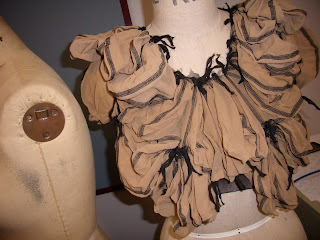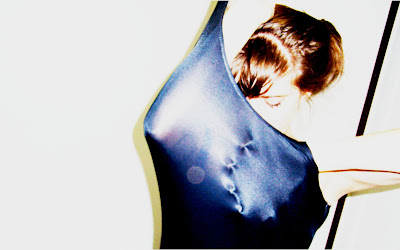Tuesday, June 8, 2010
week thirteen: how to lace your corset...
Monday, June 7, 2010
week twelve: persistent circles...

Sunday, June 6, 2010
week twelve: 'piecing it together'...





Saturday, June 5, 2010
week eleven: pantyhose...




Monday, May 31, 2010
week ten: sculpting...

week ten: corsetry...
The most common and well-known use of corsets is to slim the body and make it conform to a fashionable silhouette. For women this most frequently emphasizes a curvy figure, by reducing the waist, and thereby exaggerating the bust and hips. A shorter kind of corset, which covers the waist area (from low on the ribs to just above the hips), is called a waist cincher. A waist cincher (sometimes referred to as a Waspie) is a belt worn around the waist to make the wearer's waist physically smaller, to create the illusion of being smaller.
A corset has the influence to command the awareness of those around. It highlights the centre, the core of the skeletons frame. It protects the cluster of importance within the body, becoming a supportive armor. The chosen shape of a corset determines its power over the body. It most classically creates the hourglass figure desired by females, accentuating aspects of the form as to better shape. It ultimately crafts a smooth, reduced waistline which contours are rounded off to the hips.

Monday, May 17, 2010
week nine: dolls...

Human beings and their cultures have perennially focused attention on the female body as a source of aesthetic pleasure, sexual attraction, fertility, and reproduction. The female body occurs in a range of shapes. The female figure is typically narrower at the waist than at the bust and hips, and usually has one of four basic shapes: banana, pear, apple or hourglass. The bust, waist, and hips are called inflection points, and the ratios of their circumferences define these basic shapes. Usually, the bust area will depend on the person's weight and height.
Alteration of the body shape
Various strategies are sometimes employed to temporarily or permanently alter the shape of a body. At times artificial devices are used or surgery is employed. Breast size can be artificially increased or decreased. Breast Prostheses or padded Bras may be used to increase the apparent size of a woman's breasts, while minimiser bras may be used to reduce the apparent size.
Historically, the greatest efforts have been made to reduce a woman's waist line. Boned corsets were used for several centuries, but during the twentieth century these were mostly replaced with more flexible foundation garments. Where corsets are used for waist reduction, it may be temporary reduction by occasional use or permanent reduction by people who are often referred to as tightlacers. Liposuction is the common surgical method of reducing the waist size.
Padded control briefs or hip and buttock padding may be used to increase the apparent size of hips and buttocks. Buttock augmentation surgery may be used to increase the size of hips and buttocks and to make them more rounded.
Women simply aspire to amplify and intensify their natural physic to craft the ideal body. I intend to simply emphasis its form by honoring its imperative fundamentals. This will be carried out through the arrangement of colour and fabrication to mold and highlight features.
Saturday, April 24, 2010
week seven: neo...



Friday, April 16, 2010
week six: image development

Thursday, April 1, 2010
week five: swimmers...





week four: beautify me...






Saturday, March 27, 2010
week four: briefly...


week three: second skin...





Wednesday, March 24, 2010
week three: leg in


Saturday, March 20, 2010
week two: the singlet....
This week I found the unfamiliar process of fitting the material to the mannequins an entirely alien concept. A mannequins 3d form is a realistic and accurate representation of the human bodies shape, allowing us to mould the fabric to its shell. This unique process ensured that we produced a basic singlet shape that was specific to our personal needs or liking. Relying heavily on sight to draw in the shape of the straps and necklines created a sense of freedom, opening up paths to design resolutions. Thought my singlet needed no adjustments in relation to fit, I felt that the line I chose for the straps did not translate on the body and may need modifying in order achieve the most flattering outcome for the wearer. Whilst witnessing my work on a human model it became apparent how the singlet highlights the female hourglass frame, disclosing a hint of subtle suggestiveness from the most understated item of clothing.
Like a second skin, the elastic cotton of a singlet hugs the body’s form, no matter the shape or size, free flowing every kind of movement, no matter how strenuous or extreme. Often it is the last layer of privacy, offering a tantalizing glimpse of naked flesh. Stretch fabric is a thin and subtle fabric that clings to the tiniest undulations of the bodyand leaves very little to the imagination. Through a singlet you can detect the curves of the bust and abdominal muscles. It reveals the line of a shoulder blade, the dip in the collarbone and smooth contours of the hips.
In completion of the 'cut and paste' exercise I wanted to explore that process of stretching/fitting the fabric in a new way. My aim was not to over design, with complex construction, but to execute and explore to a high standard. With the fabric we selected in class I wanted to emphasis tension across the arms in the form of the added straps that hang from the side seams. To do so I eliminated shoulder seams to minimize bulk and create smooth base for the twisted and pulled fabric. The porous net fabric stressed with force in areas under pressure, this created varied depth visible from the slight differences in pink tones. The intensity that was created by simply straining the fabric over the shape of the strap and stay stitching, embodies a sophisticated intention of 'stretch' within the design. Not only does it draw in through its design detail, but is efficient in its function, providing a wide range of methods to be exhibited.

Monday, March 15, 2010
week one: geometric thoughts




Sunday, March 14, 2010
week one: t is for shirt.....

From the start of week 1 I began to question the basic components of a t-shirt. I had never really looked at the construction or fit of a t-shirt to an extent. Thus in trying to think of ways to alter a t-shirt my natural thought process was challenged. It felt impossible to visualize a final outcome, causing me to scrutinize and probe a t-shirt of my own to find potential in movement and document from there. This type of design process intrigued me, not only future outcomes but discovering other viable methods of formulating new solutions.
The word 'generic' seemed prevalent within the introductory class to the Stretch Generics studio. I felt as though I couldn't comprehend its significance within the course brief. "By considering the examples of STRETCH generic garments, students will be challenged to propose new design solutions and applications that break away from customary clothing genres associated with these materials." In order to generate innovative and contemporary designs we must first study these 'generic' garments. To consider a specific item characteristic of or relative to its class or genus, in its most common form. For me this will involve a thorough deconstruction of these basic items to create opposed, conceptual prototypes that have derived from their primary state.
(above image from www.toxel.com/.../uploads/ 2009/04/tshirts04.jpg viewed 13/3/10)



